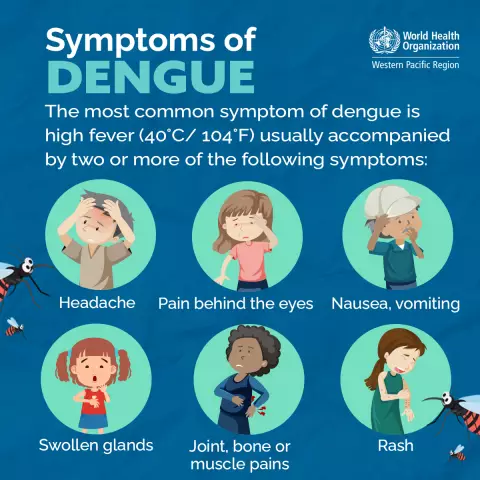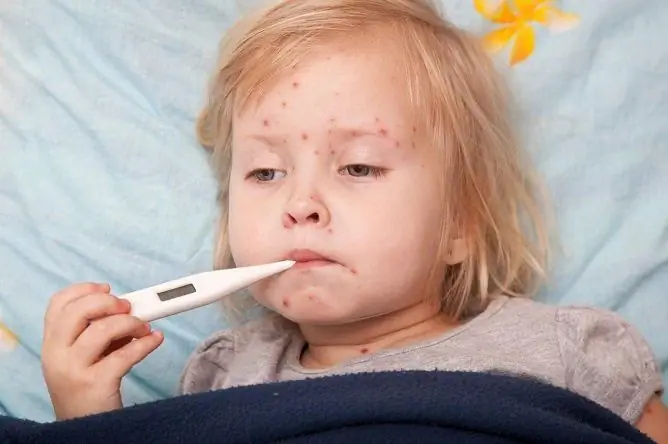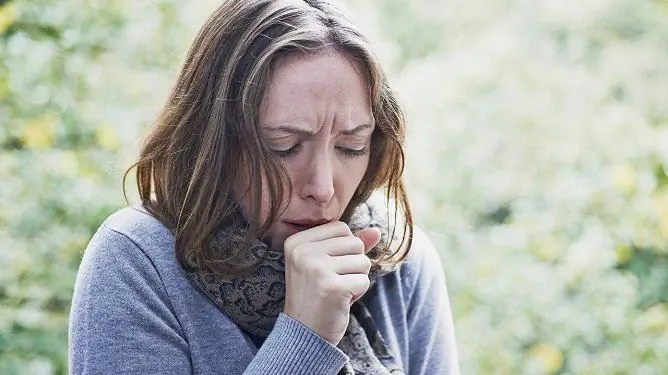- Author Rachel Wainwright [email protected].
- Public 2023-12-15 07:39.
- Last modified 2025-11-02 20:14.
Scarlet fever in children
The content of the article:
- Causes and risk factors
- Disease stages
- Symptoms of scarlet fever in children
- Diagnostics
- Treatment of scarlet fever in children
- Nutrition for children with scarlet fever
- Traditional methods of treating scarlet fever in children
- Potential consequences and complications
- Forecast
- Prevention of scarlet fever in children
Scarlet fever in children is an infectious disease that often occurs in preschool children, caused by group A streptococci and proceeding with angina, fever and the formation of a characteristic small-dot rash on the skin and mucous membranes.

Symptoms of scarlet fever in children
The disease is recorded in all countries of the world, but more often in regions with cold or temperate climates. In organized groups, the incidence is 3-4 times higher than among children who do not attend kindergartens and schools. The largest number of cases of scarlet fever in children is recorded in the autumn-winter-spring period.
The natural susceptibility of children to scarlet fever is high. After the transferred disease, persistent type-specific immunity is formed, however, infection of the child with another serovar of the pathogenic group A streptococcus leads to a new case of scarlet fever.
Now scarlet fever in children in most cases is mild. Experts believe that this is due to antibiotic therapy of the disease, as well as an improvement in the quality of life and nutrition of children, which helps to increase their general immunity. There are frequent cases when scarlet fever in children is diagnosed after acute inflammation subsides, on the basis of characteristic peeling of the skin. Due to untimely diagnosis, antibiotic therapy in such cases is not carried out, however, with properly organized care of a sick child, the risk of developing complications is small.
Causes and risk factors
The causative agent of scarlet fever is β-hemolytic streptococcus group A. It belongs to the facultative aerobic gram-positive bacteria. The source of infection is bacteria carriers and sick people. The greatest danger in the epidemiological plan is represented by those who fell ill in the first few days from the onset of the development of a detailed clinical picture of the disease. After three weeks, the likelihood of transmission by them practically disappears. Approximately 20% of the population are asymptomatic carriers of hemolytic streptococcus. They are able to spread the infection over many months, and sometimes even years.
Infection with scarlet fever in children occurs by airborne droplets or by contact-household through the aerosol mechanism (the release of the pathogen from a sick person occurs when talking, sneezing, coughing). Very rarely, there is an alimentary transmission of infection, which is based on the ingestion of the causative agent of the disease on food.

Infection of children with scarlet fever occurs mainly by airborne droplets or contact-household
The entrance gate for β-hemolytic group A streptococcus is the mucous membrane of the oral or nasal cavity, pharynx. It is extremely rare for an infection to enter the body through the mucous membrane of the external genital organs or damaged skin.
In the area of the introduction of pathogenic microbes, local inflammation develops (regional lymphadenitis, tonsillitis). Toxins penetrating into the blood cause intoxication of the child's body (weakness, fever), and in addition contribute to a sharp expansion of the blood capillaries. It is this expansion of the skin capillaries that is clinically manifested as a small-point specific rash.
The penetration of the causative agent of scarlet fever directly into the blood leads to damage to the hearing system, temporal bone, meninges, lymph nodes, causing the development of purulent-necrotic processes in these organs.
Over time, patients develop an immune response to the action of scarlet toxin, which leads to a decrease in inflammation, signs of intoxication and the disappearance of a skin rash.
Disease stages
In the clinical course of scarlet fever in children, several stages are distinguished:
- Incubation period. The duration is from 1 to 12 days, but most often 2-7 days. During this period, there are no symptoms of scarlet fever in children, they feel healthy, but at this time the pathogen multiplies in the body.
- The period of expanded manifestations. It lasts from 5 to 10 days and is manifested by the development of clinical syndromes characteristic of scarlet fever.
- The recovery period (convalescence). Lasts 10 to 15 days. All signs of scarlet fever in children disappear by the end of it.
Symptoms of scarlet fever in children
Scarlet fever in children in typical cases develops acutely. The clinical picture of the disease is represented by several syndromes:
- Intoxication syndrome. The child's body temperature rises, headache and muscle pain occurs, and appetite decreases. Nausea and sometimes vomiting are possible.
- Scarlet heart. Characterized by the appearance of a systolic murmur at the apex, the development of respiratory arrhythmias, deafness of heart sounds.
- Rash. It appears during the first two days from the beginning of the stage of advanced clinical manifestations and is a small-point red exanthema that develops on hyperemic (reddened) skin. The rash is localized mainly in the natural folds of the skin, in the lower parts of the anterior abdominal wall, the inner surface of the legs and the flexor surface of the arms. On the face, the rash does not cover the nasolabial triangle, and it seems pale - this phenomenon is called Filatov's symptom. With scarlet fever, children sometimes have petechial and miliary rashes. After 3-7 days, the rash disappears without leaving a trace. The rash results in flaking of the skin, most pronounced on the tips of the toes and hands. This peeling lasts 2-3 weeks and serves as the basis for retrospective diagnosis of the disease.
- Sore throat syndrome. In children, scarlet fever is accompanied by the development of inflammation of the tonsils of varying severity (from catarrhal to purulent). But most often, patients develop lacunar or follicular tonsillitis, which is characterized not only by the defeat of the tonsils, but also by an increase in regional lymph nodes, the presence of a clearly limited hyperemia of the soft palate.

Scarlet fever in children usually develops acutely, with an increase in body temperature
A characteristic sign of scarlet fever in children is the symptom of a raspberry tongue. In the first 2-3 days from the onset of the disease, the tongue is coated with a thick white bloom. Then it spontaneously peels off and acquires a bright red color with clearly visible enlarged taste buds.
It is extremely rare in children that extrabuccal scarlet fever (burn, wound) is observed. In this form of the disease, the pathogen enters the body through damage to the skin. In this case, there is no sore throat syndrome in the clinical picture of the disease. The diagnosis of extrabuccal scarlet fever is made on the basis of the exclusion of any other inflammatory processes that can cause the observed necrotic changes.
Diagnostics
Diagnosis of scarlet fever in children is usually not difficult. Interviewing and a thorough physical examination of the child allow the doctor to make the correct diagnosis based on a pronounced specific clinical picture of the disease, the epidemic situation is also taken into account.
Currently, it is extremely rare to carry out microbiological diagnostics of scarlet fever, which consists in isolating the pathogen by sowing secretions from the mucous membranes of the pharynx. This is due to the fact that streptococci are very widely represented in the microflora of the oral mucosa and therefore this method is not rational.
A specific rapid test for scarlet fever is the coagglutination reaction (RCA), which allows the antigens of group A β-hemolytic streptococcus to be isolated in the patient's secretions and as part of circulating immune complexes.
When conducting a general blood test, general changes characteristic of most bacterial infections (an increase in the number of leukocytes, a shift in the leukocyte formula to the left, acceleration of ESR) are revealed.
To assess the state of the organs of the urinary system, a general urine test, Nechiporenko's test, Zimnitsky's test, and an ultrasound examination of the kidneys are shown.

With scarlet fever in children, a blood test shows changes characteristic of the presence of an infection
If a child has symptoms of otitis media, he is consulted by an otolaryngologist with an otoscopy.
The appearance of signs indicating a streptococcal lesion of the heart muscle is the basis for performing EchoCG, ECG, as well as consulting the patient with a cardiologist.
Scarlet fever in children requires differential diagnosis with tonsillitis, pseudotuberculosis (yersiniosis), staphylococcal infection.
Treatment of scarlet fever in children
Treatment for scarlet fever in children is usually done at home. The need for hospitalization arises only with an extremely severe course of the disease or the development of complications.
Sick children are prescribed strict bed rest, which should last until the acute period of the disease subsides (7-10 days).
Etiotropic treatment of scarlet fever in children is carried out with antibiotics of the penicillin group, which are prescribed in the form of tablets or injections. The dosage, frequency of use and duration of the course of treatment are determined in each case by the attending physician, taking into account a number of factors (severity of the disease, age of the child, presence of concomitant pathology). If children have contraindications to the use of penicillin antibiotics (allergic reaction), first-generation cephalosporins, macrolides or lincosamides become the drugs of choice.
A good therapeutic effect is provided by the combined use of antibiotics and antitoxic serum.

With scarlet fever, children are prescribed antibiotics of the penicillin group
In case of severe intoxication syndrome, detoxification therapy is carried out, including the appointment of intravenous infusions of glucose and electrolyte solutions, vitamin therapy.
If it is necessary to maintain cardiac activity, the sick child is prescribed the introduction of camphor, ephedrine.
Local treatment of scarlet fever in children consists of regular gargling with antiseptic solutions (usually Furacilin solution is used) or herbal infusions (calendula, eucalyptus, chamomile).
Nutrition for children with scarlet fever
Previously, it was believed that during scarlet fever, children need to adhere to a special diet (low-protein, or dairy-vegetable), as they reduce the allergy of the body, thereby reducing the risk of complications from the myocardium and kidneys. However, the results of the research carried out did not confirm the effectiveness of this approach. Currently, the organization of nutrition for children with scarlet fever has been revised. According to modern nutritionists and infectious disease specialists, the diet of a sick child should be based on the severity of intoxication and pain syndromes.
During the period of fever, you must drink plenty of fluids, it can be different drinks warmed up to room temperature:
- milk and fermented milk drinks (drinking yogurt, kefir, yogurt, etc.);
- sweet tea with lemon;
- berry fruit drinks;
- rosehip infusion;
- compotes;
- decoctions of dried fruits;
- jelly;
- boiled or still mineral water.
If the child refuses to eat, then you should not insist on eating in the first 1-2 days of the disease, it is enough to provide an abundant drink. Then the diet should be gradually expanded, introducing light soups and fruit purees into it.

In the acute period, the child is provided with an abundant and healthy drink.
Scarlet fever in children is almost always accompanied by the development of angina, which is characterized by intense sore throat, which makes it difficult to eat. Therefore, to facilitate swallowing, food should be served in liquid or semi-liquid form. It should be warm and not irritating to mucous membranes. Carbonated drinks, honey, concentrated juices, marinades, spices, sauces, sour, spicy and salty foods are excluded from the diet. The menu should be based on the following products:
- boiled milk (slimy) porridge;
- mashed vegetable soups, cooked in weak meat, chicken or vegetable broth;
- minced meat dishes (steam cutlets, meatballs, meatballs, meatballs);
- steamed, boiled or stewed fish, poultry dishes;
- fresh and stewed fruits (excluding sour ones) in the form of mashed potatoes;
- vegetable dishes;
- dairy and fermented milk products.
After the acute symptoms of scarlet fever have subsided, children are gradually transferred to their usual diet.
Traditional methods of treating scarlet fever in children
The main treatment for scarlet fever in children is antibiotic therapy, which must be prescribed and monitored by the attending physician. Untimely onset in severe cases can lead to the development of serious complications, such as myocarditis or nephritis. However, to alleviate the child's condition and accelerate recovery, in consultation with the doctor, antibiotic therapy for scarlet fever can be supplemented with alternative methods of treatment.
During a febrile period, the child should be given tea with raspberries or cherries (if there is no allergy). These berries contain salicylic acid, which has antipyretic, anti-inflammatory and mild analgesic effects.
For gargling, it is recommended to use decoctions of medicinal herbs that have an antiseptic and anti-inflammatory effect, for example, pharmacy chamomile, calendula or eucalyptus leaves.

As an auxiliary treatment for scarlet fever, it is useful for children to gargle with chamomile or calendula.
Potential consequences and complications
Complications of scarlet fever are early and late. Early complications are associated with the ingress of the causative agent of the disease into the bloodstream and its introduction into the internal organs, which is accompanied by the development of purulent-inflammatory processes in them, and some of them can take on a life-threatening nature. Such complications include mastoiditis, otitis media, sinusitis, lymphadenitis.
The development of late complications of scarlet fever in children is associated with infectious and allergic mechanisms. These include autoimmune nephritis, arthritis, carditis.
Forecast
The use of antibiotics in the early stages of the disease can successfully treat streptococcal infections and minimize the risk of complications. Therefore, in most cases, the prognosis for scarlet fever in children is favorable. A disease that has been transferred in a mild form, in which antibiotic therapy was not carried out, also has a favorable outcome and usually does not lead to any negative consequences.
Complications of scarlet fever are rare and occur mainly when a child develops a toxic-septic form of the disease.
Repeated cases of the disease are observed in 2-3% of children.
Prevention of scarlet fever in children
Prevention of scarlet fever in children includes the following activities:
- sick children under the age of 9 are not allowed into organized children's groups for 22 days from the onset of the disease (over 9 years - within 10 days);
- when registering cases of the disease in kindergarten or primary school, quarantine is imposed for 7 days;
- if a child receives treatment for scarlet fever at home, children in contact with him are not allowed into children's groups for 17 days.
There is no vaccine against scarlet fever. The lack of need for such a vaccine is due to several factors:
- in most children, scarlet fever is mild;
- the disease is accompanied by a very low mortality rate (common flu is more often fatal than scarlet fever);
- with the timely initiation of antibiotic therapy, the risk of complications is minimal.
When a child comes into contact with a patient with scarlet fever, in some cases, to prevent infection, he may be prescribed the introduction of bicillin, a long-acting antibiotic of the penicillin series. Bicillin does not allow the beta-hemolytic streptococcus of group A that has entered the baby's body to multiply and thereby prevents the development of scarlet fever.
Bicillin prophylaxis of scarlet fever is not a mandatory measure; the need for it is determined by the doctor. As a rule, it is prescribed to young children with a high initial allergy of the body, since their scarlet fever is likely to be complicated by the development of autoimmune pathologies.
YouTube video related to the article:

Elena Minkina Doctor anesthesiologist-resuscitator About the author
Education: graduated from the Tashkent State Medical Institute, specializing in general medicine in 1991. Repeatedly passed refresher courses.
Work experience: anesthesiologist-resuscitator of the city maternity complex, resuscitator of the hemodialysis department.
The information is generalized and provided for informational purposes only. At the first sign of illness, see your doctor. Self-medication is hazardous to health!






